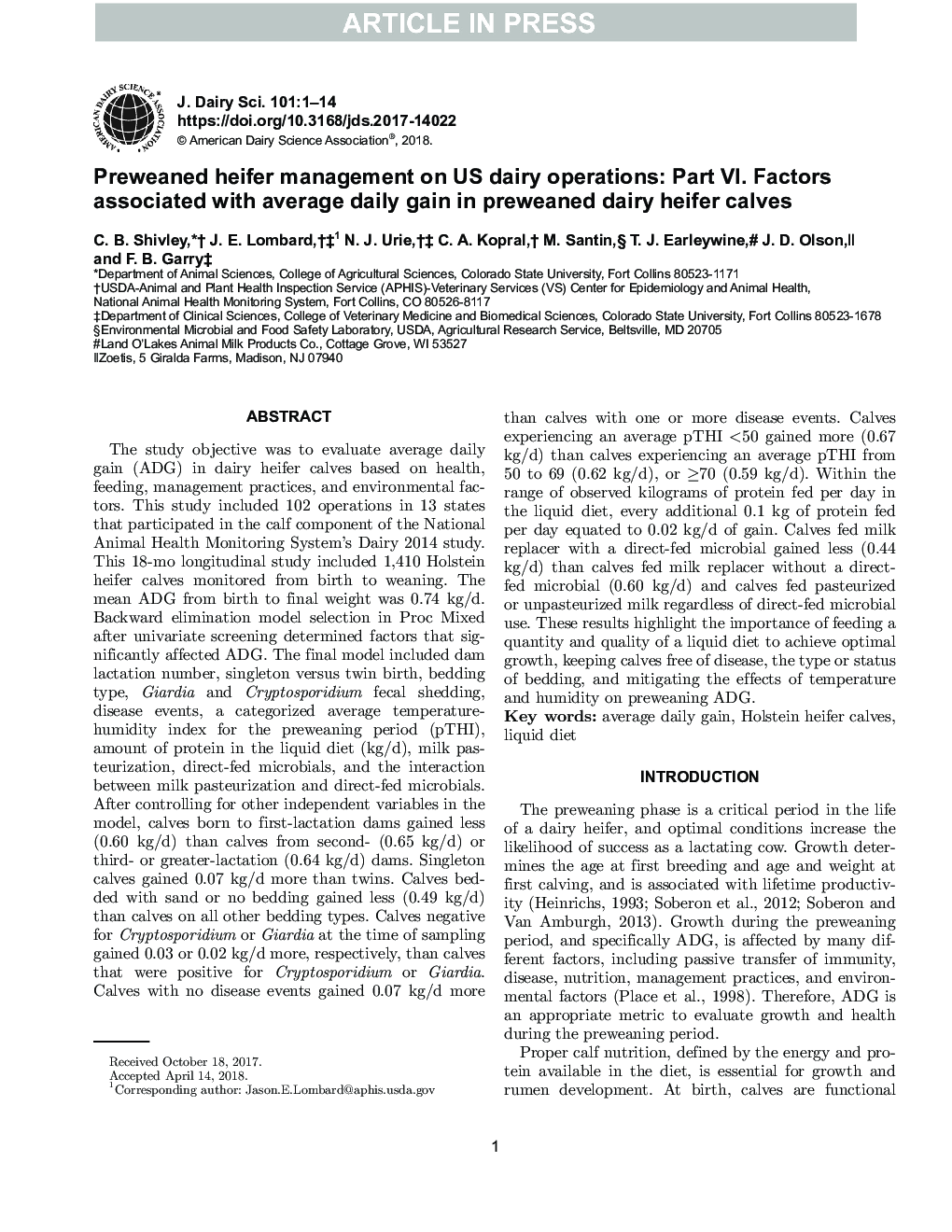| کد مقاله | کد نشریه | سال انتشار | مقاله انگلیسی | نسخه تمام متن |
|---|---|---|---|---|
| 10158084 | 1666505 | 2018 | 14 صفحه PDF | دانلود رایگان |
عنوان انگلیسی مقاله ISI
Preweaned heifer management on US dairy operations: Part VI. Factors associated with average daily gain in preweaned dairy heifer calves
دانلود مقاله + سفارش ترجمه
دانلود مقاله ISI انگلیسی
رایگان برای ایرانیان
موضوعات مرتبط
علوم زیستی و بیوفناوری
علوم کشاورزی و بیولوژیک
علوم دامی و جانورشناسی
پیش نمایش صفحه اول مقاله

چکیده انگلیسی
The study objective was to evaluate average daily gain (ADG) in dairy heifer calves based on health, feeding, management practices, and environmental factors. This study included 102 operations in 13 states that participated in the calf component of the National Animal Health Monitoring System's Dairy 2014 study. This 18-mo longitudinal study included 1,410 Holstein heifer calves monitored from birth to weaning. The mean ADG from birth to final weight was 0.74 kg/d. Backward elimination model selection in Proc Mixed after univariate screening determined factors that significantly affected ADG. The final model included dam lactation number, singleton versus twin birth, bedding type, Giardia and Cryptosporidium fecal shedding, disease events, a categorized average temperature-humidity index for the preweaning period (pTHI), amount of protein in the liquid diet (kg/d), milk pasteurization, direct-fed microbials, and the interaction between milk pasteurization and direct-fed microbials. After controlling for other independent variables in the model, calves born to first-lactation dams gained less (0.60 kg/d) than calves from second- (0.65 kg/d) or third- or greater-lactation (0.64 kg/d) dams. Singleton calves gained 0.07 kg/d more than twins. Calves bedded with sand or no bedding gained less (0.49 kg/d) than calves on all other bedding types. Calves negative for Cryptosporidium or Giardia at the time of sampling gained 0.03 or 0.02 kg/d more, respectively, than calves that were positive for Cryptosporidium or Giardia. Calves with no disease events gained 0.07 kg/d more than calves with one or more disease events. Calves experiencing an average pTHI <50 gained more (0.67 kg/d) than calves experiencing an average pTHI from 50 to 69 (0.62 kg/d), or â¥70 (0.59 kg/d). Within the range of observed kilograms of protein fed per day in the liquid diet, every additional 0.1 kg of protein fed per day equated to 0.02 kg/d of gain. Calves fed milk replacer with a direct-fed microbial gained less (0.44 kg/d) than calves fed milk replacer without a direct-fed microbial (0.60 kg/d) and calves fed pasteurized or unpasteurized milk regardless of direct-fed microbial use. These results highlight the importance of feeding a quantity and quality of a liquid diet to achieve optimal growth, keeping calves free of disease, the type or status of bedding, and mitigating the effects of temperature and humidity on preweaning ADG.
ناشر
Database: Elsevier - ScienceDirect (ساینس دایرکت)
Journal: Journal of Dairy Science - Volume 101, Issue 10, October 2018, Pages 9245-9258
Journal: Journal of Dairy Science - Volume 101, Issue 10, October 2018, Pages 9245-9258
نویسندگان
C.B. Shivley, J.E. Lombard, N.J. Urie, C.A. Kopral, M. Santin, T.J. Earleywine, J.D. Olson, F.B. Garry,